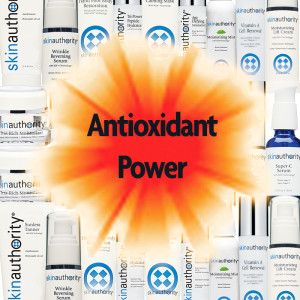 Antioxidants are substances that prevent oxidation damage to cells. Some of the most well known antioxidants are vitamin A, vitamin C, vitamin E, and Pycnogenol®. The highest concentration of antioxidants in the body is contained in the epidermal layer of the skin, forming a protective barrier for the living dermal layer and the internal body. With age, the concentration of antioxidants in the skin declines considerably. Without the protective capacity of this layer, damage to the skin increases. Only about 1% of orally ingested antioxidants will arrive at the skin. Antioxidants applied topically can help restore an effective barrier and help reduce further damage.
Antioxidants are substances that prevent oxidation damage to cells. Some of the most well known antioxidants are vitamin A, vitamin C, vitamin E, and Pycnogenol®. The highest concentration of antioxidants in the body is contained in the epidermal layer of the skin, forming a protective barrier for the living dermal layer and the internal body. With age, the concentration of antioxidants in the skin declines considerably. Without the protective capacity of this layer, damage to the skin increases. Only about 1% of orally ingested antioxidants will arrive at the skin. Antioxidants applied topically can help restore an effective barrier and help reduce further damage.
By maintaining an ideal level of antioxidants at the skin level, we can control free radical and oxidation damage. The action of antioxidants can reduce or partially neutralize the harmful power of free radicals (FR). The combination of antioxidants and sunscreen is a powerful and effective way to hinder FR activity.
Oral ingestion is one way to get antioxidant vitamins into skin, but body control mechanisms tightly regulate the levels of ingested vitamins. Furthermore, most people don’t get adequate supplies of antioxidant nutrients through diet. Applying antioxidants topically is a way to increase skin levels to help protect against reactive oxygen species (ROS) – provided the antioxidants first get into the skin, and then are in a form the body can use.
When applied topically, combination antioxidants can provide up to a four-fold antioxidant protection, and prevent the formation of thymine dimmers in irradiated skin. Each topical application of antioxidants will have an approximate life of up to four days with decreasing concentration. Daily reapplication can keep levels maximized.
Pycnogenol® is a powerful scavenger of FR as well as an antioxidant. It has been clinically shown to be 20 times more potent than vitamin C and 50 times more powerful as vitamin E. It restores the strength of capillaries and improves circulation, making it easier in treating the capillary fragility of aging skin. Pycnogenol® enhances the effectiveness of both vitamin C and vitamin E.
Vitamin C (L-Ascorbic Acid) is needed to produce collagen, the skin protein. If part of the topically applied vitamin C is consumed in antioxidant functions to reduce oxidative stress, eliminate FR, and repair oxidative damage, then less vitamin C is available for collagen production. By adding Pycnogenol® to formulations containing antioxidant vitamins, the Pycnogenol® quickly performs the antioxidant functions, leaving more of the vitamin available to perform its therapeutic functions. By pairing these two antioxidants, the vitamin C performs more collagen generating functions, causing collagen production to be faster and more extensive.
Vitamin A is often referred to as the “normalizer.” It is essential not only for normal skin development, but for the growth and maintenance of bones, glands, teeth, nails, and hair. Vitamin A is absorbed through the skin, helping it to remain soft and plump, and improves the skin’s water barrier proprieties. The generic term for vitamin A and its derivatives is “retinoid”. Vitamin A is involved in the growth and repair of epithelial cells. These cells cover the internal and external surfaces of the body.
Vitamin E acts like an antioxidant and can inhibit the formation of lipid peroxides. Thus, it may play a role against aging, especially in the skin, since lipid peroxidation in tissues may be one of the causes of skin aging.
Glycolic acids smooth the way for vitamins. As the smallest molecular AHA, it opens the skin by exfoliation of the top most layer. It penetrates deep into the skin, and, prepares the way for vitamins. Certain vitamins, used in conjunction with glycolic acid, offer double protection against FR, and assist their antioxidant, bleaching, and firming effects.

